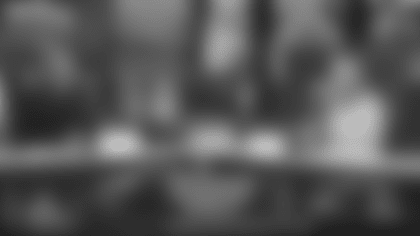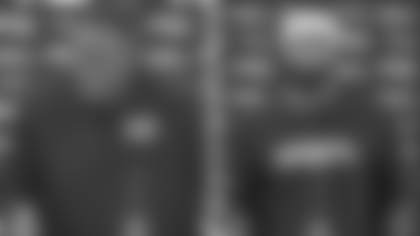New England Patriots head coach Bill Belichick addresses the media during his press conference at Gillette Stadium on Friday, November 6, 2009.
BB: It's been a couple weeks since we played. Last week was good, everybody got a little bit of a break. I think the team's anxious, ready to play again. We know it's a big challenge against Miami, but I think they're anxious and ready to go. It will be good to get back out on the field here. [We've got] one more day to tie a few lose ends together, but I think we're looking forward to playing.
Q: Can you talk about the decision to cut Kendall Simmons?
BB: Kendall really worked hard. I really have a lot of admiration for him, he's a pro. He came to work early, stayed late, worked hard. [We're] just managing the roster here. That's part of it. It was definitely not something we were looking to do, but we've got to try to manage our team.
Q: Do you anticipate filling the roster spot soon?
BB: Yeah, we'll definitely fill it. We actually have to fill it.
Q: So who's getting the call?
BB: We'll have a meeting on it this afternoon.
Q: The rookie corners that Miami are starting, you don't see that often. What have you seen from them?
BB: Well, up until Will Allen was injured, they pretty much split time at right corner in the preseason. Vontae [Davis] played the left corner and [Sean] Smith played the right corner, when both of them were in, which was quite a bit of time. They wanted to see both of the rookie guys play. So with Will out, then Vontae has gone back to playing the left side, like he did in preseason, in the last two games. They're big, athletic. Vontae is probably close to six feet. [Davis] is a solid guy at 200 and whatever he is. Smith is big, 6-3. [He's] a tall guy, long arms, runs well. They both run well. [They're] bigger corners that have good ball skills, good range, long guys. They play a lot of press coverage and try to get up there on the receivers. They do that quite a bit.
Q: Will there be a portion of the game from drive to drive in which you're trying to figure out how they're protecting those players and if they are at all?
BB: We deal with that every week, to see how teams are playing us, what they're doing coverage-wise and how they're matching up. They played them in single coverage, against a lot of guys they played, whether it's the Reggie Wayne's, Roddy White's or Brayland Edwards. It's like any defense, really. Sometimes you help the corners, sometimes you stop the run, sometimes you blitz, sometimes you don't help anybody. They do all those. How exactly they're going to play us? We'll have to wait and see. They've shown the ability to play different ways and I'm sure they'll have those ready and feature one or another, but we won't know that until game time.
Q: Because of Sean Smith's size does he present a different challenge for receivers trying to get off the line.
BB: Yeah, definitely. He's tall, he's long. You don't see many corners that tall. You can probably go through and name those corners that size and it would be a pretty short list - the Bobby Taylor's, guys like that. There aren't very many of them that are 6-3 out there. He's definitely unique from that standpoint.
Q: As far as getting off the line, how different is it for a receiver?
BB: You are dealing with a longer guy. He's not only tall, but he's got long arms. When he gets his hands on those receivers, it keeps them off him. They don't run the routes a lot of times or close the defender like they do against some other players. That's one of the advantages those guys have. Like I said, the Bobby Taylor's of the world. There's not many of them, but when you see one, they have a little different style of play.
Q: Sometimes when you are playing a team like the Dolphins you want to watch the game in real time other than the film and the cut ups to see how fast they are. Did you do that at all this weekend?
BB: In real time?
Q: The live telecasts of the games as opposed to watching the plays divided up?
BB: I'm not really following you. It's the same plays and the film we watch is real time. So if you want to chart the hang times on a punt, you can do it off our film, it is real time.
Q: With Julian Edelman being here and Brandon Tate working his way in, do you see Benjamin Watson and Chris Baker as options in terms of receiving?
BB: I think with Tom [Brady], every eligible receiver is an option. He throws to everybody. He throws to the backs, throws to the tight ends, throws to the receivers. I think everybody knows when they're involved in the route, depending on the coverage and how the patterns get matched up. We've thrown the ball to each of them or all of them, probably all five of them for the most part. We call a play, and in this coverage he's going over here, and on that coverage he's going over there, and if it's zone it's going to these guys and when it's man he's going to those guys. I think when everybody runs a route, they all know that everybody's alive, depending on what the defense does. If they pressure us or whatever happens, everybody knows they could get the ball.
Q: Can you talk about what an effective tight end could do for an offense?
BB: I think, generally speaking, the tight end could be the hardest position to match up on for a defense because it's hard to put a linebacker on the real good receiving tight ends, like some of the guys we've seen: [Tony] Gonzalez, guys down the road - [Jeremy] Shockey, Dallas Clark. [With] guys like that, the linebackers just can't cover - or I should say it's hard for them to cover - and the defensive backs who have the speed to cover them, they're outweighed by 20, 30, 40 pounds [and] maybe give up two, three, four inches in height and length. So that's an issue. It's really hard to find a guy that's the same size as a Tony Gonzalez, or the same size as a Dallas Clark or Jeremy Shockey, players like that that can cover them. You're either finding a smaller guy that can run with him or a bigger guy that can be physical with them, but probably can't run or doesn't have their kind of quickness. So it's a tough matchup, whereas the receivers and corners are much more matched, physically, for the most part. Every once in a while, you see those big, 6-4, 225-pound receivers that are hard to match up against. But for the most part those physical matchups are more in line than with a good receiving tight end. That's the challenge of those guys. They're really receivers in a tight end's body. Those are tough match-ups.
Q: Since Randy Moss has been here, how has he evolved or changed as a player?
BB: In talking to Randy, when he came here from Oakland and Minnesota, I think what we do offensively is quite a bit different than what he did in those two places. I'm not saying it's better or worse, I'm just saying it's different - lining up in different formations, playing in the slot, being in motion, being in different two-, three-, four-, sometimes five-receiver sets, depending on formations. That changes some things, so I think that was different for him. Certainly, not anything he had trouble with. From day one, as I've said before, he's the smartest receiver I've ever been around. He not only knows what he's doing, he knows what everybody else is doing. He knows what the defense is doing and he usually knows what the quarterback is doing with the ball, based on all that information he compiles in a very short amount of time - a couple to pre-read and then maybe a half a second or second into the play. As far as he's evolved, it's just playing in a different offense and doing all those things - running different routes, being in different alignments, working with Tom [Brady], then Matt [Cassel], then Tom again, of course timing and adjustments and things like that. A lot of the routes he runs are adjustable routes. It depends on where the defenders are, what he does, whether he goes inside or outside, or whether he goes deep or hooks up. Things like that, not all of them, but there is a decent amount of them. That's definitely him and the quarterback seeing the same thing and each of them anticipating what the other one's going to do. That's all part of it. I don't think it's anything that's earth-shaking, it's just something that takes timing, work and coordination.
Q: Why is he so smart in that regard?
BB: He just is.
Q: If you were a guy that doesn't have the same level of skill he does, you are just trying to get your route run correctly. When you have the wonderful skill he does physically, can he see the game on a different level because he doesn't have to worry about the other things?
BB: No. I think you get a bunch of people in the room and some people ... If the TV's busted, some people can walk in there and fix it. I look at it, all I see is wires - TV, VCR, Sirius Radio, whatever it is. It all looks the same to me. It's just a bunch of wires and if it doesn't work ... If I hit the button and it doesn't turn on, that's it. There're other people that come in there and "boom, boom, boom," everything works. The computer works, the TV works, the VCR works, the VHS works, everything, perfect. Some people have a capacity to see some things. Some people have trouble with math, some people have trouble with the English language - I have trouble with both of them. There're all different strengths and weaknesses. You coach players, some guys see things, they see everything. Some guys, they see nothing.
Q: Did you know he was that incredible?
BB: Well, I'd never coached him before. The people I talked to that knew him, that were his teammates and that were with him in Minnesota or Oakland, a couple of people I talked to that's pretty much what they said.
Q: You talk about guys that can play the X, the Z and the slot. Is it just mental? Is that why it is so hard for a guy to be versatile enough to play all three different spots or do you need to be that versatile physically, too?
BB: No, there're definitely physical skills that are involved, there's no question about it. It's hard to play on the outside of a formation without a lot of speed because you don't really threaten the vertical part of the field for those guys; they sit on you and don't have very many routes. It's hard to play in the inside part of the field without some quickness to find those spaces because - usually, when you line up in the middle of the field - there is at least one guy, if not two, that are on top of the formation that are deep, so it's hard to run by them because they're already so far back there. Again, it's being instinctive. Like a basketball player, knowing when to pull up, when to drive to the hoop, when to pull up for the jump shot, when he can make it to the basket and when he can't and when to pull out. It's all that stuff. And some guys have an instinctiveness and a capacity to do that without even being coached. You run a play and say this is what we're going to do on this play, "boom", "boom." [Then] you go out there and run a play and something happens that you didn't even talk about, some guys will do what they're supposed to do and other guy's will, 'Well I should do this, but here's what they did so obviously I can't do that, so I adjusted into something else.' And it's the right thing to do. Lawrence Taylor was like that. Lawrence Taylor knew what every player on the field was doing. I'm not saying he was a coach, but OK, well, 'I'm here, this guy's here, that guys there, so obviously that guy's got to be over there, that guys got to do this.' I think guys that try to memorize plays, 'OK, I run this on that play. I run that on this play. I do this on some other play.' And then it runs together and they kind of make mistakes. Whereas, 'OK, I run this, well of course I've got to run this because that guys here, that guys there and that guys somewhere else. So where else would I be?' It's just easy for them. It's just natural. Some players have a great capacity for it [and] other guys - you tell them to key one guy [and] they come off after the play and you say, 'What did that guy do?' 'Oh, I didn't see him.' Well. that's the guy you're keying, but sometimes that happens. Some guys see it, some guys ... Brady, I mean from day one, Brady, you ask what happened after a play and he'd tell you eight things that happened. I dropped back, the lineman flashed in front of me, the linebacker dropped wide, this guy slipped, he was over here, the other guy flashed on this side, I stepped up, this happened, that happened. You go back and watch the film and there are the eight things that he said happened [and] that's what happened on the play. You can see every one of them. This guy was pressed and then he backed off late, this guy rolled down. Like I said, Lawrence [Taylor] was like that, too. Lawrence would go out there, come in after the series and say, 'Coach, they're not blocking it the way you said they were going to block it. Here's what they are doing. Instead of him taking me, he's helping. I can see that guy looking for me, so if I come inside, the centers going to come off and he's going to pick me up.' You can look at the film and say he's right. You could never get that from the sideline.
Q: Just judging by the names you're throwing out there, I assume that that kind of adaptability and having that both physically and mentally is really rare?
BB: Yeah, that's what makes them special. That's what makes Tom Brady, Tom Brady. That's what makes Randy Moss, Randy Moss. That's what made Lawrence Taylor, Lawrence Taylor. They just have that sixth, seventh sense. It's like Brady, you see a guy coming at him from the backside and you say, 'he doesn't see him coming and look out he's going to get hit.' And he either ducks or throws the ball right before the guy gets there and makes those kinds of plays. You see running backs, you think somebody's going to come in there, and clean him up from behind, and at the last second they stop or they duck and the guy goes right over the top. And you think, 'How did he see that guy?' But they just know. Emmitt Smith was like that. You watch him run, you get the end zone film, he's got the ball and you're saying, 'There's no hole there,' and he finds four or five yards out of it. He sets up a block, squirts through, gets his pad down and it's second and five. Where's that yardage? We had this defended great, there's no place to go and he ... So some of those runs, some of those three-, four-yard runs that those great backs make, they're some of the best runs I've ever seen. Barry Sanders, that guy could gain four yards and it would be a spectacular play. It's not just the 80-yarders, it's the ones when there's nothing there and the guy creates a four-, five-yard gain out of literally nothing - three or four guys miss blocks, but he finds some way to take what little there is and make something out of it.
Q: When you have guys at the combine and have guys in for free agent visits, looking at video and explaining what you were doing on this play so valuable?
BB: I think there's something to be said for that. But on the other hand there are guys that can, when you watch film, look at it in the classroom and look at it in a book, they'll give it to you chapter and verse, forwards and backwards. And then you get out there on the field and spatially here's the same stuff we went over in the meeting, here's the same thing we watched on film, and it happens on the field and they don't recognize it, or they're late to recognize it. And then there are other guys that don't understand it in the diagram, they don't really understand it. But then you get out there spatially and say, 'OK, when this guy is here' ... Oh, OK. We all have different ways of learning. It's interesting how that happens. I'm not saying everybody's like that, but sometimes you can get misled by that. You think, 'Well, somebody comes in and they can draw 100 different plays.' But then you get out there on the field and they miss. But you get guys like Brady and Moss and guys like that; they get it at every level. You diagram something, 'Oh, yeah I can picture that.' You see this play? When this guy is here, you go there. [They respond,] 'Of course, I would go there, what else would I do?' It just comes easy to them. They get out there on the field and they make adjustments during the game, they just instinctively know what to do. Sometimes they see it a lot quicker than the coaches do and that's good for us.








































